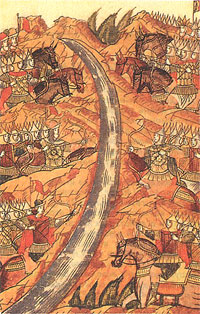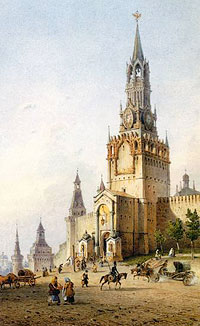 |
| Stand on the Ugra River. Chronicle miniature. 14th century. |
In his wrath, Achmet rose up with his forces against Russia, boasting that he would destroy the holy churches and take all of the Orthodox captive, as during the time of Batei.
The danger was very threatening: the heavy work of the Russian national life could have withered in one fell swoop, and two centuries of bloody labor of a whole generation might have disappeared without a trace.
When the Russian and Tatar forces stood facing each other across the Ugra River, which was covered with thick ice, they were ready to fight. John began to retreat in order to choose a more suitable place for battle, when suddenly fear fell upon both armies, and they ran away from each other, neither of them pursued by anyone.
Achmet left Russia altogether and never returned.
Thus, the yoke was cast off without any bloodshed. All of their contemporaries saw a miracle in this; they glorified God's mercy and said, "Let not the light-minded boast in the fearsomeness of their weapons! No, neither weapons nor the wisdom of men, but the Lord has saved Russia today!" Here are the words of the Chronicles: "Then there was a miracle of our most glorious and pure Sovereign Lady, the Mother of God. Fear of God came upon King Achmet and he fled from the Ugra River not pursued by anyone. Thus did God deliver the Russian land from the heathen, through the prayers of the Most Pure One, the great wonder-workers, and all the saints. Amen.
The Ugra was named the "cincture of the Mother of God," since the Mother of God protected the Russian land according the faith of the Russian people.
Russia rejoiced that year in its final freedom from the Mongol Yoke, and the Metropolitan instituted the annual commemoration of that event on June 23 [July 5, N.S.] with the feast of the most glorious Vladimir Icon of the Mother of God and a cross procession from the Kremlin to Sretensky Monastery.
* * *
Memory of the Mongol Yoke faded further and further away. The work of gathering the Russian land was completed.
In 1521, in the reign of John III's son Vasily III, the Crimean Khan Mehmet-Girei, thinking to break speedily Russia's growing strength, advanced upon Moscow, laying lands to waste, killing and capturing people, doing evil.
Having scattered the Russian forces by the River Oka, he joined forces with the Khan of Kazan and spread his tents on Vorobevy Hills. Preparing for the attack, amongst conflagrating villages and clouds of smoke, he came ever closer.
With no army and no tsar, Moscow trembled and prayed. In those terrifying days, when help was slow to come from on high, a vision that several people saw revealed to Moscow the great prayerful intercessors who cared for her.
A solemn cross procession began from the Florovsky gates of the Kremlin.
With candles and incense, lamps, hierarchical fans, and banners, the clergy of the Church went forth carrying the miraculous icon of the Mother of God along with other icons; after them came the synaxis of Moscow hierarchs, and then a crowd of people. The higher powers had abandoned Moscow because of her sins.
Then, from the marketplace of St. Elias, ran Sts. Sergius of Radonezh and Varlaam of Khutyn. With tears they fell down before the holy hierarchs, begging them not to abandon the city in its danger, and with long, tearful requests they persuaded them to serve a moleben for the softening of God's wrath.
They grieved greatly before the holy hierarchs, and finally the whole, great synaxis unanimously fell to praying, sang canons before the Vladimir Icon, and cried out to the Mother of God for Her intercession; then they returned to the city.

|
| Weiss. The Spassky Gates of the Moscow Kremlin. 1852. |
Twice the Khan sent many people to burn the surroundings, but they returned in horror with the news that a multitude of armed forces stood around the walls.
The Khan asked one of his trusted advisors to learn the truth. The latter also returned trembling. "O Tsar," he said, "why are you hesitating? Let us run! A numberless multitude of soldiers is advancing upon us from Moscow!"
This was a vision. The Khan retreated.
On May 21 [June 3 N. S.] Moscow commemorates this miraculous deliverance with a cross procession, and therefore it has become a tradition for men to remove their hats as they pass by the gates which came to be called "Spassky" [Gates of the Savior]. To the right of them is now a chapel with the miraculous icon which is greatly venerated by Muscovites of Sts. Sergius of Radonezh and Varlaam on Khutyn in prayer before the Savior. On the Kremlin side of the gates is an icon of Holy Hierarchs Peter and Alexei, praying to the Mother of God.
